

Compact Muon Solenoid
LHC, CERN
| CMS-PAS-SUS-16-026 | ||
| Search for electroweak production of charginos and neutralinos in the WH final state at 13 TeV | ||
| CMS Collaboration | ||
| August 2016 | ||
| Abstract: A search is performed for beyond the standard model physics in events with a leptonically-decaying W boson, a Higgs boson decaying to a pair of b-quarks, and missing transverse energy, using 12.9 fb−1 of data recorded by CMS in 2016 at √s= 13 TeV. This signature is predicted to occur, for example, in supersymmetric models from electroweak production of gauginos. The observed data are in agreement with the standard model prediction. The results are used to set cross section limits on chargino-neutralino production in a simplified model of supersymmetry with the decays ˜χ±1→W˜χ01 and ˜χ02→H˜χ01. | ||
| Links: CDS record (PDF) ; inSPIRE record ; CADI line (restricted) ; | ||
| Figures & Tables | Summary | Additional Tables | References | CMS Publications |
|---|
| Additional information on efficiencies needed for reinterpretation of these results are available here. |
| Figures | |
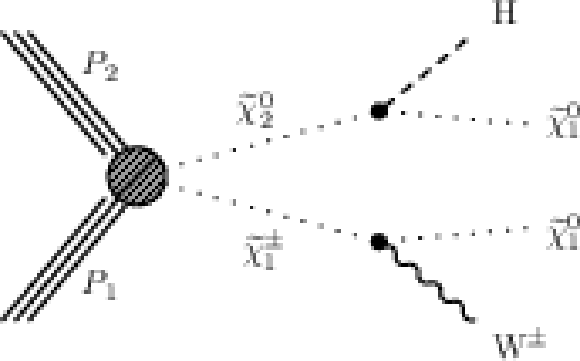
png pdf |
Figure 1:
Feynman diagram of the SUSY simplified model targeted by this analysis: chargino-neutralino production with the chargino decaying to the W boson and the LSP, while the second neutralino decays to the Higgs boson and the LSP. |
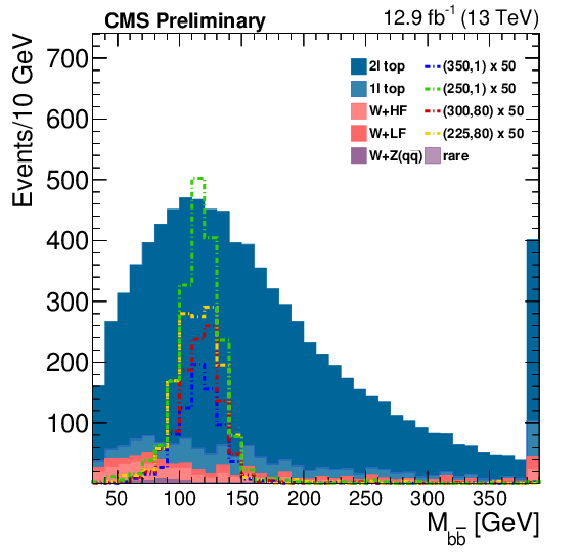
png pdf |
Figure 2-a:
Distributions of Mbˉb (a), ETmiss (b), MT (c), and MCT (bottom right) for signal and background events in simulation after the preselection. The ETmiss, MT, and MCT distributions are shown after the 90 <Mbˉb< 150 GeV requirement. Signal distributions are also overlaid as open histograms for various mass points. The legend entries for signal give the masses (m˜χ±1,m˜χ01) and the amount by which the signal cross section has been scaled for display purposes. |
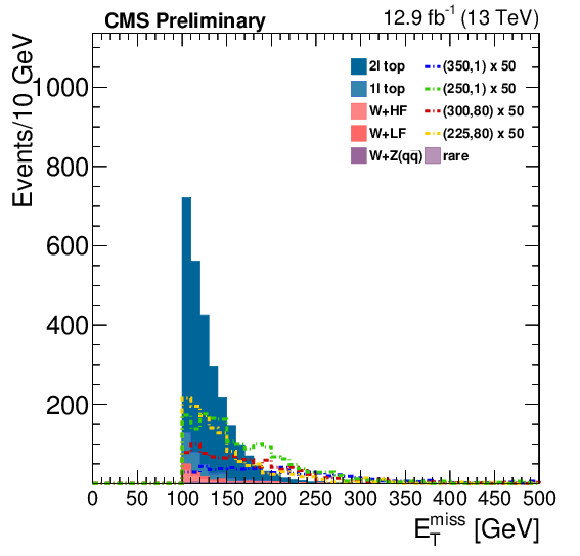
png pdf |
Figure 2-b:
Distributions of Mbˉb (a), ETmiss (b), MT (c), and MCT (bottom right) for signal and background events in simulation after the preselection. The ETmiss, MT, and MCT distributions are shown after the 90 <Mbˉb< 150 GeV requirement. Signal distributions are also overlaid as open histograms for various mass points. The legend entries for signal give the masses (m˜χ±1,m˜χ01) and the amount by which the signal cross section has been scaled for display purposes. |

png pdf |
Figure 2-c:
Distributions of Mbˉb (a), ETmiss (b), MT (c), and MCT (bottom right) for signal and background events in simulation after the preselection. The ETmiss, MT, and MCT distributions are shown after the 90 <Mbˉb< 150 GeV requirement. Signal distributions are also overlaid as open histograms for various mass points. The legend entries for signal give the masses (m˜χ±1,m˜χ01) and the amount by which the signal cross section has been scaled for display purposes. |

png pdf |
Figure 2-d:
Distributions of Mbˉb (a), ETmiss (b), MT (c), and MCT (bottom right) for signal and background events in simulation after the preselection. The ETmiss, MT, and MCT distributions are shown after the 90 <Mbˉb< 150 GeV requirement. Signal distributions are also overlaid as open histograms for various mass points. The legend entries for signal give the masses (m˜χ±1,m˜χ01) and the amount by which the signal cross section has been scaled for display purposes. |

png pdf |
Figure 3-a:
(a) Distribution of Mbˉb in CR2ℓ after preselection requirements, comparing data to MC simulation. (b) Distribution of Mbˉb in CRMbˉb after preselection requirements. |

png pdf |
Figure 3-b:
(a) Distribution of Mbˉb in CR2ℓ after preselection requirements, comparing data to MC simulation. (b) Distribution of Mbˉb in CRMbˉb after preselection requirements. |

png pdf |
Figure 4:
Distribution of Mbˉb after all signal region kinematic requirements. The signal region corresponds to the bins with 90 <Mbˉb< 150 GeV. The hatched band shows the total uncertainty on the background prediction, including statistical and systematic components. The signal distribution for a reference mass point is overlaid as an open histogram, and the legend entry for signal gives the masses (m˜χ±1,m˜χ01). |

png pdf root |
Figure 5:
Expected and observed cross section limits at the 95% CL as a function of the chargino mass, where the LSP is assumed to have a mass of 1 GeV. The NLO theoretical cross section for production of ˜χ±1˜χ02 is also shown, assuming these are pure wino states. |
| Tables | |

png pdf |
Table 1:
Control region selections compared with the signal region. |
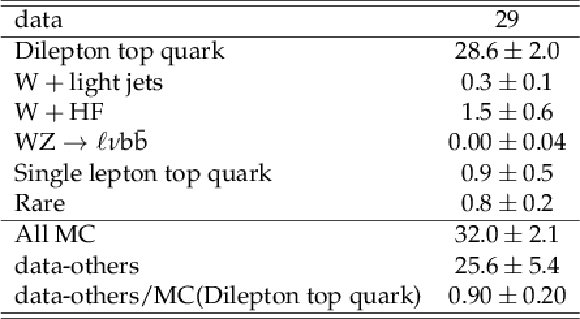
png pdf |
Table 2:
Predicted and observed yields for CRMbˉb after the signal region requirements on EmissT, MT, and MCT. The observed data yield is compared to the MC prediction for the dilepton top quark background after subtracting the predictions for the other (non-dilepton top quark) backgrounds. The uncertainties shown are statistical only, and the uncertainty on the ratio includes the statistical uncertainty on the data and MC samples. |

png pdf |
Table 3:
Yields for CR0b, after all signal region requirements, including MT> 150 GeV. The observed data yield is compared to the W+light-jets MC prediction after subtracting the prediction for the other (non W+light-jets) backgrounds from the data yield. The uncertainties shown are statistical only, and the uncertainty on the ratio includes the statistical uncertainty on the data and MC samples. |
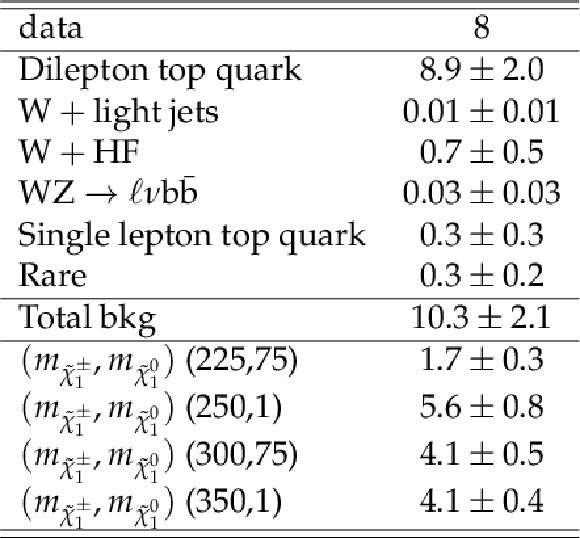
png pdf |
Table 4:
Expected and observed yields in the signal region. The expected yields for some example signal points are also given. The uncertainties include both statistical and systematic sources. |
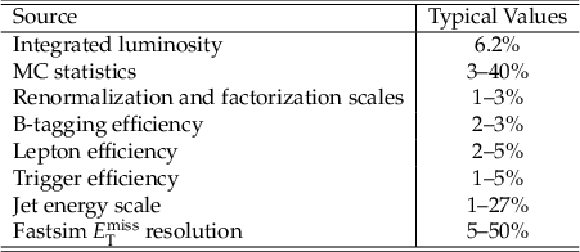
png pdf |
Table 5:
Sources of systematic uncertainty on the estimated signal yield along with their typical values. The ranges represent variation across the signal masses probed. |
| Summary |
| A search was performed for beyond the standard model physics in events with a leptonically-decaying W boson, a Higgs boson decaying to a bˉb pair, and EmissT, using 12.9 fb−1 of data recorded by CMS in 2016 at √s= 13 TeV. The observed data are in agreement with the standard model expectation. The results were used to set cross section limits on chargino-neutralino production in a simplified SUSY model with the decays ˜χ±1→W˜χ01 and ˜χ02→H˜χ01. |
| Additional Tables | |
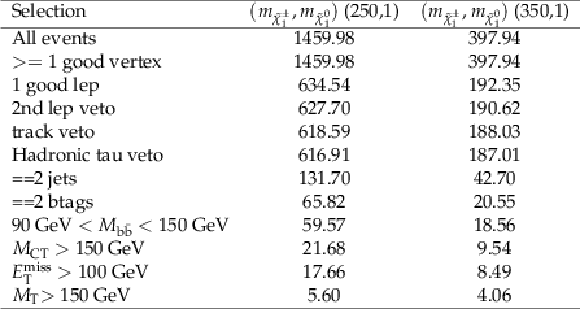
png pdf |
Additional Table 1:
Cutflow yields for the signal pp→˜χ±1˜χ02 with the decays ˜χ±1→W˜χ01 and ˜χ02→H˜χ01. The ``All events'' category below starts from all generated events where the W boson decays leptonically and the Higgs boson decays to a bˉb pair. |
| References | ||||
| 1 | P. Ramond | Dual theory for free fermions | PRD 3 (1971) 2415 | |
| 2 | Y. A. Golfand and E. P. Likhtman | Extension of the algebra of Poincar\'e group generators and violation of P invariance | JEPTL 13 (1971)323 | |
| 3 | A. Neveu and J. H. Schwarz | Factorizable dual model of pions | Nucl. Phys. B 31 (1971) 86 | |
| 4 | D. V. Volkov and V. P. Akulov | Possible universal neutrino interaction | JEPTL 16 (1972)438 | |
| 5 | J. Wess and B. Zumino | A Lagrangian model invariant under supergauge transformations | PLB 49 (1974) 52 | |
| 6 | J. Wess and B. Zumino | Supergauge transformations in four dimensions | Nucl. Phys. B 70 (1974) 39 | |
| 7 | P. Fayet | Supergauge invariant extension of the Higgs mechanism and a model for the electron and its neutrino | Nucl. Phys. B 90 (1975) 104 | |
| 8 | H. P. Nilles | Supersymmetry, supergravity and particle physics | Phys. Rep. 110 (1984) 1 | |
| 9 | C. Boehm et al. | Light Scalar Top Quarks and Supersymmetric Dark Matter | PRD 62 (2000) 035012 | hep-ph/9911496 |
| 10 | C. Bal\'azs et al. | Dark Matter, Light Stops and Electroweak Baryogenesis | PRD 70 (2004) 015007 | hep-ph/403224 |
| 11 | CMS Collaboration | Searches for electroweak neutralino and chargino production in channels with Higgs, Z, and W bosons in pp collisions at 8 TeV | PRD 90 (2014), no. 9, 092007 | CMS-SUS-14-002 1409.3168 |
| 12 | CMS Collaboration | Searches for electroweak production of charginos, neutralinos, and sleptons decaying to leptons and W, Z, and Higgs bosons in pp collisions at 8 TeV | EPJC 74 (2014), no. 9 | CMS-SUS-13-006 1405.7570 |
| 13 | ATLAS Collaboration | Search for the electroweak production of supersymmetric particles in √s=8 TeV pp collisions with the ATLAS detector | PRD 93 (2016), no. 5, 052002 | 1509.07152 |
| 14 | N. Arkani-Hamed et al. | MARMOSET: The path from LHC data to the new standard model via on-shell effective theories | hep-ph/0703088 | |
| 15 | J. Alwall, P. Schuster, and N. Toro | Simplified models for a first characterization of new physics at the LHC | PRD 79 (2009) 075020 | 0810.3921 |
| 16 | J. Alwall, M.-P. Le, M. Lisanti, and J. G. Wacker | Model-independent jets plus missing energy searches | PRD 79 (2009) 015005 | 0809.3264 |
| 17 | D. Alves et al. | Simplified models for LHC new physics searches | JPG 39 (2012) 105005 | 1105.2838 |
| 18 | CMS Collaboration | Interpretation of searches for supersymmetry with simplified models | PRD 88 (2013) 052017 | CMS-SUS-11-016 1301.2175 |
| 19 | CMS Collaboration | Particle-flow event reconstruction in CMS and performance for jets, taus, and EmissT | CDS | |
| 20 | CMS Collaboration | Commissioning of the particle-flow event with the first LHC collisions recorded in the CMS detector | CDS | |
| 21 | CMS Collaboration | Performance of electron reconstruction and selection with the CMS detector in proton-proton collisions at √s=8~TeV | JINST 10 (2015) P06005 | CMS-EGM-13-001 1502.02701 |
| 22 | CMS Collaboration | Performance of CMS muon reconstruction in pp collision events at √s=7 TeV | JINST 7 (2012) P10002 | CMS-MUO-10-004 1206.4071 |
| 23 | CMS Collaboration | Description and performance of track and primary-vertex reconstruction with the CMS tracker | JINST 9 (2014) P10009 | CMS-TRK-11-001 1405.6569 |
| 24 | M. Cacciari, G. P. Salam, and G. Soyez | The anti-kT jet clustering algorithm | JHEP 04 (2008) 063 | 0802.1189 |
| 25 | M. Cacciari, G. P. Salam, and G. Soyez | FastJet User Manual | EPJC 72 (2012) 1896 | 1111.6097 |
| 26 | M. Cacciari and G. P. Salam | Pileup subtraction using jet areas | PLB 659 (2008) 119 | 0707.1378 |
| 27 | CMS Collaboration | Identification of b-quark jets with the CMS experiment | JINST 8 (2013) P04013 | CMS-BTV-12-001 1211.4462 |
| 28 | CMS Collaboration | Missing transverse energy performance of the CMS detector | JINST 6 (2011) P09001 | CMS-JME-10-009 1106.5048 |
| 29 | D. R. Tovey | On measuring the masses of pair-produced semi-invisibly decaying particles at hadron colliders | JHEP 04 (2008) 034 | 0802.2879 |
| 30 | G. Polesello and D. R. Tovey | Supersymmetric particle mass measurement with the boost-corrected contransverse mass | JHEP 03 (2010) 030 | 0910.0174 |
| 31 | J. Alwall et al. | MadGraph 5: going beyond | JHEP 06 (2011) 128 | 1106.0522 |
| 32 | P. Nason | A new method for combining NLO QCD with shower Monte Carlo algorithms | JHEP 11 (2004) 040 | hep-ph/0409146 |
| 33 | S. Frixione, P. Nason, and C. Oleari | Matching NLO QCD computations with parton shower simulations: the POWHEG method | JHEP 11 (2007) 070 | 0709.2092 |
| 34 | S. Alioli, P. Nason, C. Oleari, and E. Re | A general framework for implementing NLO calculations in shower Monte Carlo programs: the POWHEG BOX | JHEP 06 (2010) 043 | 1002.2581 |
| 35 | NNPDF Collaboration | Parton distributions for the LHC Run II | JHEP 04 (2015) 040 | 1410.8849 |
| 36 | J. Alwall et al. | The automated computation of tree-level and next-to-leading order differential cross sections, and their matching to parton shower simulations | JHEP 07 (2014) 079 | 1405.0301 |
| 37 | \GEANTfour Collaboration | Geant 4 -- a simulation toolkit | NIMA 506 (2003) 250 | |
| 38 | S. Abdullin et al. | The fast simulation of the CMS detector at LHC | J. Phys. Conf. Ser. 331 (2011) 032049 | |
| 39 | CMS Collaboration | Search for direct top squark pair production in the single lepton final state at √s=13TeV | CMS-PAS-SUS-16-002 | CMS-PAS-SUS-16-002 |
| 40 | CMS Collaboration | Measurement of the WZ production cross section in pp collisions at sqrt(s) = 13 TeV | CMS-PAS-SMP-16-002 | CMS-PAS-SMP-16-002 |
| 41 | A. L. Read | Presentation of search results: The CLs technique | JPG 28 (2002) 2693 | |
| 42 | T. Junk | Confidence level computation for combining searches with small statistics | NIMA 434 (1999) 435 | hep-ex/9902006 |
| 43 | G. Cowan, K. Cranmer, E. Gross, and O. Vitells | Asymptotic formulae for likelihood-based tests of new physics | EPJC 71 (2011) 1554 | 1007.1727 |
| 44 | ATLAS and CMS Collaborations | Procedure for the LHC Higgs boson search combination in summer 2011 | CMS-NOTE-2011-005 | |
| 45 | B. Fuks, M. Klasen, D. R. Lamprea, and M. Rothering | Gaugino production in proton-proton collisions at a center-of-mass energy of 8 TeV | JHEP 10 (2012) 081 | 1207.2159 |
| 46 | B. Fuks, M. Klasen, D. R. Lamprea, and M. Rothering | Precision predictions for electroweak superpartner production at hadron colliders with Resummino | EPJC 73 (2013) 2480 | 1304.0790 |

|
Compact Muon Solenoid LHC, CERN |

|

|

|

|

|

|